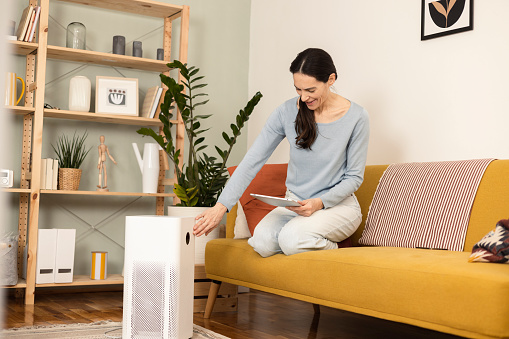
You don’t have to be a yogi or meditation expert to appreciate the benefits of good-quality air. We all want to breathe easier. But that’s not going to happen if your home is filled with contaminants, dust, and pet dander. Stale air from your heating system blasting all winter long hasn’t helped either.
We may not be quite ready to throw open those windows. And as soon as we are, we’re only inviting more allergens into our homes. So what can you do to improve your air quality? Here are six simple tips that will make a real difference and make breathing easy all summer long.
- Change your air filter every few months.
Clogged, dirty air filters not only reduce air flow from your system but also introduces excess allergens and unwanted particles into your living spaces. So you’re basically hitting yourself with a double whammy. To keep your air conditioning system running efficiently, simply change your filter! It will prevent spiking energy bills and keep your air a lot clearer. The Department of Energy recommends replacing your air filters every month or two during the summer, and every three months the rest of the year.
- Keep humidity at bay.
More moisture equals more bacteria. And in the spring and summertime, there’s lots of it! So by removing excess water in the air, you can reduce the amount of mold and other unwanted particles floating around your home. Dehumidifiers are a fairly cheap and easy way to get a handle on your humidity.
- Routinely vacuum carpenters and rugs
If you have pets, this is a MUST. But even if you don’t, vacuuming once a week can significantly reduce the amount of dust and dander that’s just sitting in your home for you to breathe in daily. Don’t stop there, make sure you also clean other areas known for collecting dust, like blinds, window sills, and bedding. The frequency with which you clean those areas will depend largely on the size of the space and how often it’s used. Cluttered spaces often build up more allergens than others, while those that tend to remain vacant will more easily collect dust too.
- Add some plants to your space.
Did you know there are a lot of plants that can actually detoxify your air for you? It’s true. Several varieties actually remove dust and germs stored in furniture and other materials throughout your home. A couple of low-maintenance, air-purifying plants that also look pretty cool and classy are aloe vera plants, pothos plants, and snake plants.
BUT keep in mind that some plants will have the reverse effect by fostering the growth of mold. If indoor allergens are a real problem for you, make sure the plants you choose are actually helping and not making things worse.
5. Use vents to remove cooking fumes.
This one couldn’t be any easier. After cooking big meals, turn on your vents right away! While most people only think to use exhaust fans when they burn the meatloaf, they are actually super helpful in quickly eliminating unwanted moisture and odors that if let to linger, will only hinder your air’s quality.
6. Invest in an air purifier.
If you’re struggling to figure out or control the source of your pesky indoor allergens, try an air purifier — specifically an ionic purifier. When placed in the most commonly used areas of the home, they can capture many of the irritants that keep you sniffling and sneezing all day long. It won’t eliminate them completely, but it will definitely make a difference.
If you’re looking for more help ensuring your air quality is the very best this spring, contact the experts at Madsen Inc. Our furnace and air handlers can make sure your system is optimized for the best airflow and will keep your home comfortable all season long.


